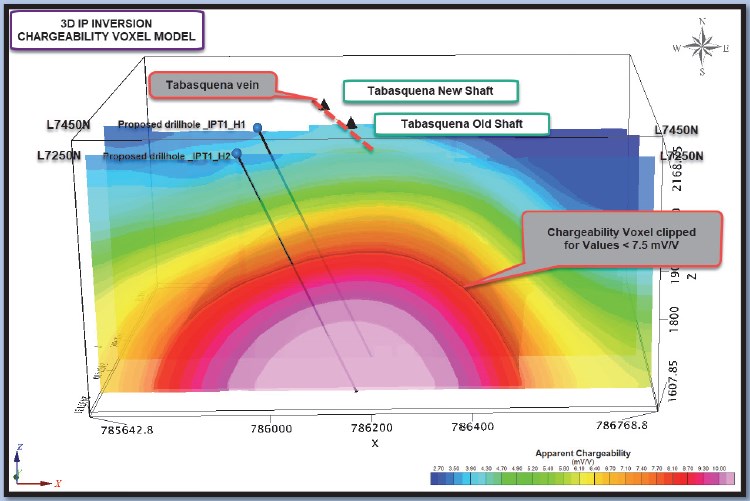Kamloops,
British Columbia–(Newsfile Corp. – November 6, 2019) – Advance Gold
Corp. (TSXV: AAX) (“Advance Gold” or “the Company”) is pleased to
announce that the recently completed second phase of 3D Induced
Polarization (IP) geophysical survey on its Tabasquena project in
Zacatecas, Mexico, has significantly increased the size of its
continuous chargeability anomaly. This anomaly now has an east-west
width of approximately 400 to 500 metres and an apparent strike length
of over 1000 metres. The anomaly remains open to the north and to the
south and at depth.
Images
below are east-west cross sections representing key portions of the
overall anomaly where upcoming drilling will test this continuous
chargeability anomaly.
Line 7350N
To view an enhanced version of Line 7350N, please visit:
https://orders.newsfilecorp.com/files/5492/49483_ee273a13f4482b50_001full.jpg
Line 7150N
To view an enhanced version of Line 7150N, please visit:
https://orders.newsfilecorp.com/files/5492/49483_ee273a13f4482b50_002full.jpg
Allan Barry Laboucan, President and CEO of Advance Gold Corp. commented: “After
our first phase of geophysics, we identified a large chargeability
anomaly with the highest chargeability at the southern end of the grid
and still wide open. In that southerly direction we have elevation
relief and it was also where the anomaly appeared to be closest to
surface. Prior to drilling this anomaly, we decided to carry out a
second phase of geophysics to see if the anomaly continued to the south.
The second phase of geophysics has revealed that the anomaly actually
has a much longer strike length and appears to be somewhat wider. This
chargeability anomaly is now at least 1000 metres from north to south
and approximately 400 to 500 metres from east to west. It sits below a
network of veins with widespread gold and silver mineralization that
ranges from anomalous to high-grade gold. There are three shafts on the
property that go down around 100 metres that were used in the historical
mining of the oxide zone of the Tabasquena vein. The geophysical
anomaly is primarily right below those shafts, starting at approximately
200 metres below the underground workings. It is fair to say that we
have identified a major target. Our next step will be to drill this
target, we expect to start this shortly and will put out a news release
once it has started.”
Gennen McDowall, Geophysical Advisor to Advance Gold Corp. commented:
“This southerly extension to the original IP grid has shown that the
large chargeability anomaly first detected in August is actually much
bigger than originally thought and appears to strike right across the
claim group and shows little evidence of ending either to the north or
to the south and its depth extent is as of yet unknown. The
chargeability anomaly is visible on every east-west IP line. The
observed near surface mineralisation may be an expression of a much
larger mineralised body underlying the entire Tabasquena project.”
Details of Geophysical Survey
The
first 3D Induced Polarization survey was carried out by GEOFISICA TMC
SA de CV, between August 3rd and August 14th, 2019. Approximately 9.6
kms of IP data was collected over the central portion of the company’s
claims. This was followed up by a second phase of geophysics consisting
of 5 east-west lines. The southerly extent of the second survey reached
just beyond the Tesorito shaft. An off-set pole dipole array was used.
Data
processing and inversion of the data was carried out using RES3DINV
software. The inversion model was extended to approximately 550 metres
below surface. 3D Voxel images together with a series of depth slices
were generated (all available on the company’s website).
The
main purpose of the IP survey was to map, laterally and at depth the
evolution of the known gold and silver veins and to identify any new
mineralised structures. The survey was designed in such a way to allow
approximately 500 to 550 metres of vertical depth investigation.
The
IP survey area encompassed the historic and new shafts that are located
to the east of the Tabasquena and Nina veins that define a mineralised
system that outcrops at surface for 2.0 km. From past exploration work,
the Tabasquena vein was recognized over approximately 70 m along strike
near the shafts but only at shallow depth (< 100 m).
The
fourteen (14) vertical sections that were extracted from the 3D IP
inversion voxels suggest the presence of (4) four main stratigraphic
horizons (lithological units) mainly characterized by their resistivity
signatures.
The
IP data also clearly shows that the large polarisable body/target is
apparently quickly deepening northward and getting closer to surface
southward. The IP anomaly starts at around 100 metres below the past
drill hole intersections that contained widespread gold and silver
mineralization in epithermal veins.
Chargeability
and resistivity anomalies are indicated on the IP sections (see report
on company’s website) and are graded as per their relative strength.
Those chargeability anomalies that are deemed to be caused by the same
anomalous target are grouped together in what is called a polarisable
axis. Only one main axis was delineated following the review of the IP
data, which was labelled IPT-1 (Map C351-3 & Figure 11, report on
company website). This axis is a single large amplitude continuous
chargeability anomaly running north-south, coincident with the two
shafts at Tabasquena, the Tesorito shaft and the surface projection of
the mineralised veins. This anomaly has been categorized as having a
high chargeability and is conductive. The anomaly has an average depth
of approximately 250 to 300 meters. It should also be mentioned that
this anomaly is visible on every line, albeit less intense on the most
northerly line, as the target is becoming deeper to the north.
In conclusion
This
geophysical work has now identified a large consistent chargeability
anomaly that can be seen on all lines, implying a strike extent of at
least 1000 metres and an apparent width of 400 to 500 metres. This
observed IP anomaly could define a much wider mineralised system at
depth.
The
main recommendation of the original geophysical report was that prior
to drilling the anomaly the 3D IP survey should be extended to the
southeast for at least 1 km in the direction of the Tesorito shaft. This
has now been completed and this new work has established that the main
anomaly does in fact continue past the Tesorito shaft and is somewhat
wider. A number of boreholes are now planned to intersect this anomaly.
Julio
Pinto Linares is a QP, Doctor in Geological Sciences with specialty in
Economic Geology and Qualified Professional No. 01365 by MMSA., and QP
for Advance Gold and is the qualified person as defined by National
Instrument 43-101 and he has read and approved the accuracy of technical
information contained in this news release.
About Advance Gold Corp. (TSXV: AAX)
Advance
Gold is a TSX-V listed junior exploration company focused on acquiring
and exploring mineral properties containing precious metals. The Company
acquired a 100% interest in the Tabasquena Silver Mine in Zacatecas,
Mexico in 2017, and the Venaditas project, also in Zacatecas state, in
April, 2018.
The
Tabasquena project is located near the Milagros silver mine near the
city of Ojocaliente, Mexico. Benefits at Tabasquena include road access
to the claims, power to the claims, a 100-metre underground shaft and
underground workings, plus it is a fully permitted mine.
Venaditas
is well located adjacent to Teck’s San Nicolas mine, a VMS deposit, and
it is approximately 11km to the east of the Tabasquena project, along a
paved road.
In
addition, Advance Gold holds a 13.23% interest on strategic claims in
the Liranda Corridor in Kenya, East Africa. The remaining 86.77% of the
Kakamega project is held by Barrick Gold Corporation.
For further information, please contact:
Allan Barry Laboucan,
President and CEO
Phone: (604) 505-4753
Email: [email protected]




















